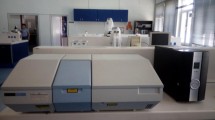Abstract
Vacuum insulation panels (VIPs) provide high thermal resistances properties that can enhance the energy efficiency of the insulating systems and provide savings in energy consumption. They are generally made with porous core materials wrapped, under vacuum, in airtight barrier films. The properties of the core materials have big effect on the thermal insulation performance and mechanical properties of the VIPs. In this study, a novel VIP core formulation was developed by using a nano-powder, fiber and opacifier at different ratios. The VIP samples at various compression pressures with different vacuum levels were produced by using the obtained core formulations. Moreover, the relationship between compression pressure and density of VIP core samples was investigated; thermal conductivities of the samples were measured according to heat flow meter method at atmospheric and 0.1 mbar pressure levels. The findings were analyzed by using Datafit 7.1 software. As a result, the optimum fiber and opacifier ratio were determined as 13–20 and 15 %, respectively, for VIP prototypes obtained by using fumed silica (220 \({{\rm m}^2/{\rm g}}\)), glass fiber (avg. diameter; \({10\,\mu {\rm m}}\)) and silicon carbide (575 \({{\rm cm}^2/{\rm g}}\)). Furthermore, the effect of fiber and opacifier ratios on the VIP core densities was investigated and various equations were developed to estimate the thermal conductivity values of VIPs at atmospheric and 0.1 mbar pressure levels.
Similar content being viewed by others
References
Baetens R., Jelle B.P., Thue J.V., Tenpierik M.J., Grynning S., Uvsløkk S., Gustavsen A.: Vacuum insulation panels for building applications: a review and beyond. Energy Build. 42, 147–172 (2010)
Alam M., Singh H., Limbachiya M.C.: Vacuum insulation panels (VIPs) for building construction industry—a review of the contemporary developments and future directions. Appl. Energy 88, 3592–3602 (2011)
Kalnæs S.E., Jelle B.P.: Vacuum insulation panel products: a state-of-the-art review and future research pathways. Appl. Energy 116, 355–375 (2014)
Heinemann U.: Influence of water on the total heat transfer in ‘evacuated’ insulations. Int. J. Thermophys. 29, 735–749 (2008)
Jelle B.P.: Traditional, state-of-the-art and future thermal building insulation materials and solutions—properties, requirements and possibilities. Energy Build. 43, 2549–2563 (2011)
Wegger E., Jelle B.P., Sveipe E., Grynning S., Gustavsen A., Baetens R., Thue J.V.: Aging effects on thermal properties and service life of vacuum insulation panels. J. Build. Phys. 35, 128–167 (2011)
Boafo, F.E.; Chen, Z.F.; Wu, W.P.; Chen, Q.; Li, B.B.: Ultrafine glass fiber vacuum insulation panel for building insulation. In: Chang, S.-Y.; Al Bahar, S.K.; Zhao, J. (eds.) Advances in Civil Engineering and Building Materials, pp. 77–83. CRC Press, Boca Raton, FL (2013)
Mukhopadhyaya, P.; Kumaran, K.; Normandin, N.; van Reenen, D.: Fibre-powder composite as core material for vacuum insulation panels. In: Proceedings of the 9th International Vacuum Insulation Symposium (IVIS-2009). London, UK, 17–18 September 2009
Kwon J.S., Jung H., Yeo I.S., Song T.H.: Outgassing characteristics of a polycarbonate core material for vacuum insulation panels. Vacuum 85, 839–846 (2011)
Kwon J.S., Jung H., Yeo I.S., Song T.H.: Outgassing characteristics of a polycarbonate core material for vacuum insulation panels. Vacuum 85, 839–846 (2011)
Kim J., Lee J.H., Song T.H.: Vacuum insulation properties of phenolic foam. Int. J. Heat Mass Transf. 55, 5343–5349 (2012)
Di X., Gao Y., Bao C., Hu Y., Xie Z.: Optimization of glass fibre based core materials for vacuum insulation panels with laminated aluminium foils as envelopes. Vacuum 97, 55–59 (2013)
Hanita Coating: High barrier laminate for vacuum insulation panels (brochure). Ed B, DS No. 8101, Israel, 1–2 (2014)
DIN EN 1602:199701: Thermal Insulating Products for Building Applications Determination of the Apparent Density; German Version EN 1602:1996
DIN EN 12667:200105: Thermal Performance of Building Materials and Products Determination of Thermal Resistance by Means of Guarded Hot Plate and Heat Flow Meter Methods Products of High and Medium Thermal Resistance, German version EN 12667:2001
Author information
Authors and Affiliations
Corresponding author
Rights and permissions
About this article
Cite this article
Davraz, M., Bayrakçi, H.C. & Yusufoğlu, Y. The Effect of Fiber, Opacifier Ratios and Compression Pressure on the Thermal Conductivity of Fumed Silica Based Vacuum Insulation Panels. Arab J Sci Eng 41, 4263–4272 (2016). https://doi.org/10.1007/s13369-016-2031-8
Received:
Accepted:
Published:
Issue Date:
DOI: https://doi.org/10.1007/s13369-016-2031-8




